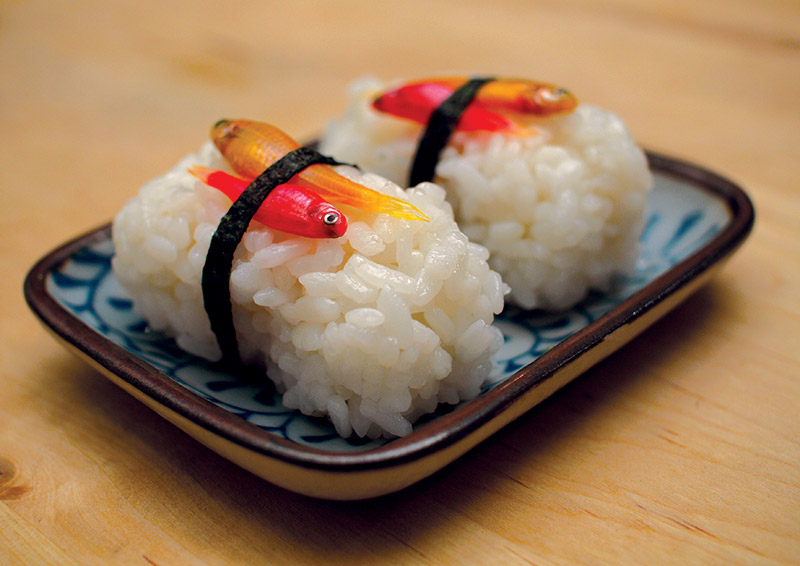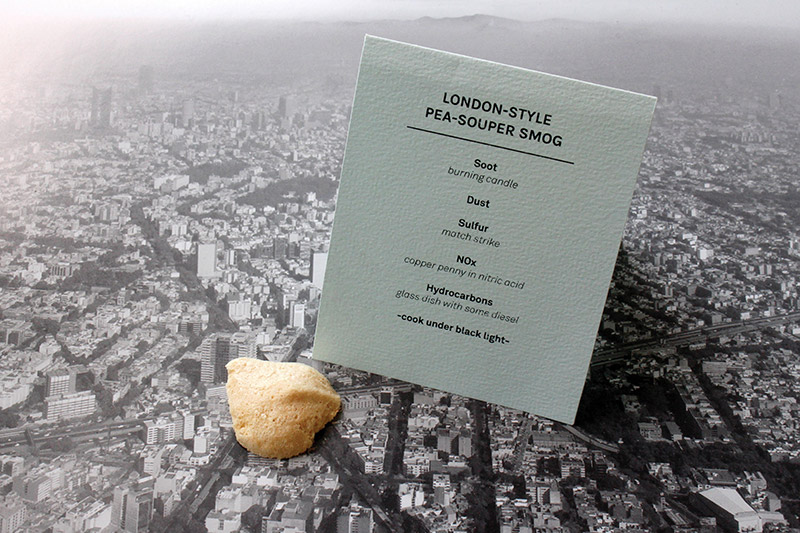These artists are prototyping alternative culinary futures to inspire food production that is more just, biodiverse, and beautiful.
We launched the Center for Genomic Gastronomy in 2010 to document the biotechnologies and biodiversity of human food systems from the perspective of the eater. It began as a bit of a satire of molecular gastronomy, which we felt was too focused on chemistry, modernity, and abstraction. We wanted to help eaters feel less alienated from the organisms and environments that are manipulated by our food cultures.
We present our research in the form of recipes, meals, publications, lectures, and exhibitions. We’ve put pop-up food carts on the streets of such cities as New York, Dublin, Panaji, and Edinburgh so we could quickly assemble organisms, ingredients, and human eaters in new configurations. For example, we rolled out a Smog Synthesizer, which simulates “aeroir,” the smell and flavor of air pollution from various places and times. Our De-Extinction Deli is a fantastical market stand designed to highlight the emerging technologies, risks, and outcomes of the movement to revive, rear, and possibly eat extinct species. The Seed-O-Matic, the world’s slowest vending machine, dispenses heirloom seeds and small bags of soil.
We use these carts to open up conversations about what values and attributes eaters want in their food and the systems that produce it. The carts are vehicles for dreaming about the future of food, prototyping it through taste, and activating culinary and ecological desires. It is especially important to make food that is both unexpected and delicious. Taste matters. Conviviality over food, taking pleasure in the daily rituals of eating, is one of the things that makes us human. Eating should connect us with each other and be pleasurable and joyous.
Let’s talk about some food futures that we don’t see as pleasurable and joyous.
Supplying mega cities with massive vats of lab-grown meat, automated vertical farms, and algae tanks does not seem beautiful, biodiverse, or delicious. Those visions abstract and standardize food and minimize seasonal variation and geographic particularities. On the other hand, imagining that everyone in the future will be supplied by glorified victory gardens and farmers markets is not much better. That dream is based on an idealized notion of how we actually grow and eat our food today. We need to imagine futures that are more unhinged and bonkers than we have come to expect from sterile science fiction or foodie goody two shoes.

A good place to start is by eating some surprising ingredients, to see what they inspire.
In these early days of the life science revolution, truth is stranger than fiction. By collaborating with scientists, chefs, biohackers, and farmers, we’ve used transgenic zebrafish in glowing sushi, air pollution in smog meringue tastings, and mutation-bred fruits in a BBQ sauce we called Cobalt-60 Sauce. When we serve ingredients like these to beta-tasters, they usually feel uncomfortable, start laughing, or both. That makes us happy, because laughter is a good indicator that people have been knocked off balance, are unable to rely on their conditioned expectations, and are thinking or seeing in a new way. Laughing induces open mouths and open minds. The Center for Genomic Gastronomy is happy to play the roles of mad scientist, mad chef, and trickster all at once.

We are now entering another phase of our work, looking at both very small and very large scales, across geographies. In our ArtMeatFlesh cooking show, we cook with the raw ingredients that are used for in-vitro meat. In pop-up Endophyte Clubs, we’re isolating the microorganisms that live inside plants and creating recipes for an entirely new agro-ecosystem based on bio-pesticides. In our Planetary Sculpture Supper Club, we create dishes that document the ways planetary patterns change in response to how and what humans eat. Fad diets (like paleo) and culinary trends (such as the rise of nut-milks) can ripple through agricultural landscapes, changing how water and land are used in only a few years. If we are going to sculpt the entire planet with our eating habits, we might as well get good at it. Unfortunately, humans are doing pretty poorly with prevention and mitigation right now, so we are also investigating adaptation, preparing ingredients that have been impacted by increasingly frequent and severe wildfires.
Tools being developed in biology will let people reinvent food systems at every scale. But what values, preferences, and desires will drive this reinvention? It is unlikely that it will resemble the totalizing diagrams used when dreaming up the “cities of tomorrow.” Instead, we envision fractal futures that look like a collection of recipe cards that can be tried, amended, and added to. Fractal futures are non-linear and messy and require connecting, tinkering, and feedback across many scales. From biology to art. From plant breeder to chef. From farm to plate to planet, and back again.
Excerpted from the book Neo.Life: 25 Visions for the Future of Our Species.












